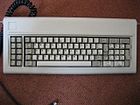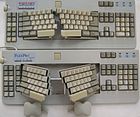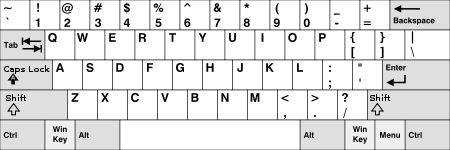- IBM PC keyboard
-
The keyboards for IBM PC compatible computers are standardized. However, during the 3-plus decades of PC architecture being constantly updated, multiple types of keyboard layout variations have been developed.
A well-known class of IBM PC keyboards is the Model M. Introduced in 1985 and manufactured by IBM, Lexmark and Unicomp, the vast majority of Model M keyboards feature a buckling spring key design and many have fully swappable keycaps.
Contents
Keyboard layouts
The PC keyboard changed over the years, often at the launch of new IBM PC versions.
Name Keys Description Image PC/XT 83 original left-hand side function key (F key) columns, F1 through F10; electronically incompatible with PC/AT keyboard types 
PC/AT 84 additional <SysRq>, i.e. System Request; numerical block clearly separated from main keyboard; added indicator LEDs for Caps/Scroll/Num lock 
Enhanced additional navigation and control keys; 12 F keys in separate row along top, grouped F1-4, F5-8, and F9-12. Early models of Enhanced keyboard (notably those manufactured by Northgate Ltd.) maintained the layout with function keys on the left side, arranged in two columns of six pairs. This layout was more efficient for touch typists but was superseded in the marketplace by that with F-keys along the top. There are different versions of the Enhanced keyboard layout: 101 standard US layout 
101 modified variation of enhanced keyboard with function keys along the left side like the older 84 key layout, but with all 12 function keys; included unique ergonomic split main section of keys 
102 additional key to the right of the left Shift key for European layouts 
103 additional 2 keys (one to the left and one to the right of the space bar) for the Korean layout 104 Brazilian ABNT NBR 10346 variant 2 (alphanumeric portion) and 10347 (numeric portion). 106 additional 5 keys (one above the tab key, one to the left of the right Shift key, one to the left and two to the right of the space bar) for the Japanese layout 
Windows[citation needed] additional Windows key (×2) and Menu key added (one Windows key to the right of the left control key, the other and the Menu key to the left of the right control key). The Windows keyboard was introduced for use with the Windows 95 operating system. Most modern PCs, whether supplied with Windows or not, are now delivered with this layout. Like the Enhanced layout, the Windows keyboard layout differs from region to region: 104 standard US layout 
105 European layouts (as above) 
106 Korean layout (as above) 
107 Brazilian ABNT NBR 10346 variant 2 (alphanumeric portion) and 10347 (numeric). 109 Japanese layout (as above)  IBM PC keyboard (Windows, US layout)
IBM PC keyboard (Windows, US layout)Esc F1 F2 F3 F4 F5 F6 F7 F8 F9 F10 F11 F12 PrtScn/
SysRqScrLk Pause/
BreakIns Home PgUp Num Lock / * - Del End PgDn 7 8 9 + 4 5 6 ↑ 1 2 3 Ent ← ↓ → 0 .
Common additions to the standard layouts include additional power management keys, volume controls, media player controls, and miscellaneous user-configurable short-cuts for e-mail client, web browser, etc.Standard key meanings
See also: Modifier key and Lock key
The PC keyboard with its various keys has a long history of evolution reaching back to teletypewriters. In addition to the 'old' standard keys, the PC keyboard has accumulated several special keys over the years. Some of the additions have been inspired by the opportunity or requirement for improving user productivity with general office application software, while other slightly more general keyboard additions have become the factory standards after being introduced by certain operating system or GUI software vendors such as Microsoft.
From mechanical typewriters
- ⇧ Shift selects the upper character, or upper case of letters. The Shift key in typewriters was attached to a lever that moved the character types so that the uppercase characters could be printed in the paper. Unlike mechanical typewriters, PC keyboards do not capitalize all letters properly when both shift keys are engaged simultaneously.
- ⇪ Caps Lock selects upper case, or if shift is pressed, lower case of letters. In mechanical typewriters, it worked like the Shift key, but also used a lock to keep the Shift key depressed. The lock was released by pressing the Shift key.
- Enter wraps to the next line or activates the default or selected option. ASCII keyboards were labeled CR or Return. Typewriters used a lever that would return the cylinder with the paper to the start of the line.
From Teletype keyboards
- Ctrl shifts the value of letters and numbers from the ASCII graphics range, down into the ASCII control characters. For example, CTRL-S is XOFF (stops many programs as they print to screen) CTRL-Q is XON (resume printing stopped by CTRL-S).
- Esc produces an ASCII escape character. It may be used to exit menus or modes.
- Tab ⇆ produces an ASCII tab character. Moves to the next tab stop.
- ~ is the tilde, an accent backspaced and printed over other letters for non-English languages. Nowadays the key does not produce a backspaceable character and is used for 'not' or 'circa'.
- ` is a grave accent or backtick, also formerly backspaced over letters to write non-English languages; on some systems it is used as an opening quote. The single quote ' is normally used for an acute accent.
- ^ is a circumflex, another accent for non-English languages. Also used to indicate exponentiation where superscript is not available.
- * is an asterisk, used to indicate a note, or multiplication.
- _ is an underscore, backspaced and overprinted to add emphasis.
- | is a vertical bar, originally used as a typographic separator for optical character recognition. Many character sets break it in the middle so it cannot be confused with the numeral "1" or the letter "l" (in most EBCDIC codepages, vertical bar and divided vertical bar are separate characters). This character is often known as a "pipe" or a "fencepost."
Invented for computers with video displays
- Function keys are the F-numbered keys, use varies by program, but F1 is often "help."
- Arrow keys move on the screen. When shifted, they select items.
- Home moves to the start of text, usually the left side of the screen.
- End moves to the end of text, usually the right-most edge of the current line.
- PgUp and PgDn move through the document by pages.
- Del (Delete) deletes the character after the screen position, or the selected items.
- Ins (Insert) toggles between "insertion" and "overwrite" mode.
- Print screen originally printed a text image of the screen; nowadays often takes a screenshot. In combination with Alt, it produces a different keycode, SysRq.
- Num lock toggles between states for the numeric keypad. When off, it acts as arrow and navigational keys. When on, it is a 10-key pad similar to a standard calculator. Preferences vary so much that a favorite default for this key can often be configured in the BIOS configuration. Its continued existence on keyboards that separate out the arrow keys has mostly historical reasons.
- Scroll lock is little-used. On modern software, typing text usually causes earlier text to scroll off the top of the screen or window. Some old programs could disable this and restart at the top of the window when scroll lock was pressed. The advantage is that the entire screen full of text does not shift, making it easier to read. It was also used to lock the cursor on its line and scroll the work area under it. On spreadsheets such as Microsoft Excel, it locks the cell pointer on the current cell, allowing the user to use the arrow keys to move the view window around without moving the cell pointer. On some consoles (such as the Linux console), it prevents scrolling of messages until another key combination is pressed.
- Pause pauses either output or processing. In combination with Control, it produces a different keycode, for Break. Ctrl-Break traditionally stopped programs in DOS. Ctrl-Break is also used to halt execution of the debugger in some programming environments such as Microsoft Visual Studio. In combination with the Windows key, it brings up the System Properties window in Microsoft Windows environments.
- Alt shifts the letters and numbers into the range above hex 0x80 where the international characters and special characters exist in the PC's standard character set. Alt plus a number typed on the numeric pad produces special characters, see Windows Alt keycodes.
- The Windows key (also known as the super key) is a quick way to open the Start menu in Windows' standard Explorer shell, and can usually be configured to behave similarly in other graphical user interfaces, for Windows and other operating systems.
- The menu key brings up a context menu, similar to right-clicking.
- AltGr works like the Ctrl+Alt key combination, often used in combination with other keys to print special characters like the backslash on non-English keyboards.
- Fn may be present on compact keyboards such as those built into laptop computers. When depressed in combination with other keys, it either enables the user to access key functions that do not have dedicated keys on the compact keyboard (such as the numeric keypad simulation block), or it controls hardware functions such as switching between the built-in screen and an external display, changing screen brightness, or changing speaker volume. These alternate meanings are usually indicated with text or symbols of a different color printed on the key, with the 'Fn' key text having that same color.
- Turbo on some keyboards. It is usually on the right side of the right Shift key. When depressed in combination with a function key it sets the key repeat rate.[1]
Connection
System Connector Pinout Transmission Protocol Command Strings Image PC 5-pin DIN
(DIN 41524)
"AT" connector1 CLK
2 DATA
3 -RESET
4 GND
5 +5V2 start bits,
8 data bits,
make/break bit (keydown/keyup),
1 stop bit
keyboard reset via pin 3 to ground
Not supported 
XT 5-pin DIN
(DIN 41524)
"AT" connector1 CLK
2 DATA
3 N/C
4 GND
5 +5V2 start bits,
8 data bits,
make/break bit (keydown/keyup),
1 stop bitkeyboard reset via sequence on DATA and CLK lines
Not supported 
AT 5-pin DIN
(DIN 41524)
"AT" connector1 CLK
2 DATA
3 N/C
4 GND
5 +5V1 start bit,
8 data,
1 parity (odd),
1 stop bit
keyboard reset via command string
Supported 
PS/2 6-pin Mini-DIN
(DIN 45322)
"PS/2 connector"1 DATA
2 N/C
3 GND
4 +5V
5 CLK
6 N/C1 start bit,
8 data,
1 parity (odd),
1 stop bitSupported 
Later
PC compatibles4-pin USB
Type A connector1 +5V
2 Data −
3 Data +
4 Groundsync field plus
8-bit bytes as packets
(HANDSHAKE, TOKEN, DATA, Special packets),
least-significant bit first.Supported 
See also
Notes
- ^ Belkin International. Knowledge Base Article 3532
External links
- IBM.com keyboard page
- Key re-mapping software:-
- SharpKeys: free
- AutoHotkey: free
Categories:- Computer keyboards
- IBM personal computers
Wikimedia Foundation. 2010.

